Apr 24, 2025
Apr 24, 2025
Introduction
Whenever the name Vivekananda is mentioned most of us have a mental picture of a Swami sitting in meditation with his eyes closed, in ochre robes and turban. Alternatively, we have also seen the picture of a man with stern penetrating eyes, with his arms folded across his chest on our walls. It has been more than a hundred years since his death, but Indians have great admiration for him as he was the first Indian to represent Hinduism in the west.
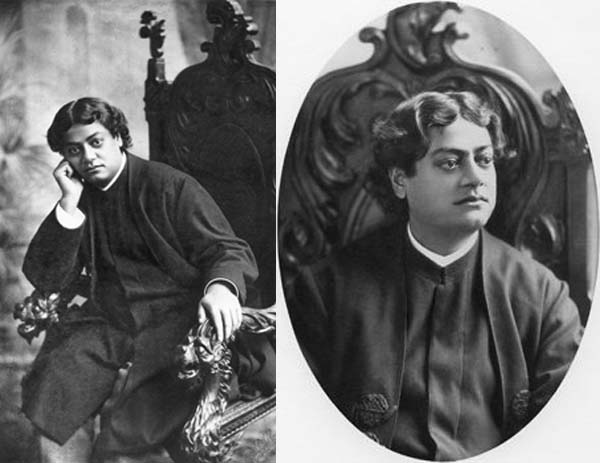
He was a contemporary of Gandhi but the two were polar opposites. While Gandhi shunned everything western as untruth and bad, Vivekananda thought he could rejuvenate and uplift the poor in India with the help of the west. To this end he partly succeeded. He was able to introduce Hinduism in a different light to the western society. The philosophy as proposed by Vedanta was also introduced by Vivekananda to the west. To some extent his success and identity was because of his recognition in the west. He had a large following in America, especially women. They were devoted to his cause and helped him set up his Vedanta Societies in America and Britain. He restored a sense of pride among Indians about their ancient religion by dispelling the myths among the westerners that Hinduism was an abhorrent caste-ridden, misogynistic, idolatrous religion. His Hindu evangelism helped people of the west to understand Hinduism as a serious religion and not some exotic, remote and occult religion of the east.
Amazingly, he achieved all this in only four short decades before he died of apoplexy at age 39! He truly believed that he could not rest until the last unfortunate human being has been helped. His personal desire for salvation could wait as long as there is suffering in this world. He rebelled against the injustice of the caste system in Hinduism and scolded priests and princes alike, if they discriminated based on the reviled caste system. To him the ideal society would be a mixture of Brahmin knowledge, Kshatriya culture, Vaisya efficiency and the egalitarian shudra ethos. Domination by any one of the castes led to imbalance and chaos.
But it is impossible to understand a man by only following his words, spoken as well as written, and a few black and white pictures. First, one needs to know the man (Narendranath Dutta) before knowing the swami (Vivekananda). Here is a brief biography of his childhood days, his training under Sri Ramakrishna and the rest of his brief adult life. We meet a brilliant man with nagging self-doubt about his duty to his family against his personal ambition of God-realization. His self-doubt even extended to his monastic life when he was conflicted whether he should renounce everything and go into self-realization on his own terms, or if he should follow the path of a karma yogi and work to uplift the downtrodden masses in India. We meet a man who had taken the vow of renunciation but did not believe in being out of touch with people and did not believe in sitting idly in his ashram. Instead he travelled across India and abroad, feeling the joy and sadness of his followers, interacting with them at all times.
Vivekananda was as dogmatic in his beliefs as pragmatic in his methods. He was convinced that mere bhakti (devotion) was like compassion without hands, meaning nothing good comes out of it for the society. Karma yoga was his calling and he was also convinced that his guru, Sri Ramakrishna had specifically wanted him to serve the poor. His desire to help everyone else before his own realization is reminiscent of the Bodhisattva of Mahayana Buddhism, who would not attain nirvana unless all the others were led to a path of salvation. This was the ultimate sacrifice of Vivekananda. God, though everywhere, can be known to us in and through human character. He was an admirer of both Buddha and Jesus Christ.
He has left a legacy behind in the form of many charitable organizations called Ramakrishna Mission and monastic orders called Ramakrishna Math throughout the world. His movement has inspired the youth of India and many Vivekananda Study Circles (VSC) have been established, wherein spiritual ideas and their practical applications are discussed. Many Vivekananda youth societies are busy working with the poor and the underprivileged with education, health and other basic needs.
Vivekananda’s success in Parliament of Religions at Chicago became a legitimizing force of Indian spiritual culture against colonialism. This also gave an early impetus for later independence movement in India resulting eventually in ousting the British rule. It also brought the message of Universalism to the forefront along with the wisdom of Vedanta. But Vivekananda was not universally accepted during his short lifetime, neither by all Americans nor by Indian Hindus. There were controversies and lack of support for his mission on both lands. He had longed for acceptance and love when he was in the west but the anticipated accolades and support from India came only after much prodding by his followers both in Calcutta and Madras.
Much is known about Vivekananda from his letters to his followers, while he stayed abroad. He also wrote regularly to his American friends. His life and his teachings were well documented first in America by his followers, who were mostly women. His honest words of truth make volumes.
He wrote to Mary Hale of Chicago, Josephine MacLeod, Sara Chapman Bull (his American Mother), Christine Greenstidel (later Sister Christine, who wrote Reminiscences of Swami Vivekananda) and to Margaret Noble (Sister Nivedita, author of The Master As I Saw Him).
Great historical work by Marie Louise Burke (Sister Gargi), Swami Vivekananda in America: New Discoveries, has thrown much light into the life and times of Vivekananda. Pravrajika Prabuddhaprana (Leona Katz) published The Life of Josephine Macleod: Friend of Swami Vivekananda and The Life of Sara Chapman Bull: The American Mother of Swami Vivekananda. Swami Nikhilananda’s Vivekananda: A Biography is a detailed study of him from an Indian’s perspective. Swami’s younger brother Bhupendranath Dutta has chronicled his early family life in his book Swami Vivekananda: A Patriot-Prophet – A Study. Another publication with a wealth of information is The Life of Swami Vivekananda: by his Easter and Western Disciples (Advaita Ashrama), first published in 1912.
An Intellectual Foundation
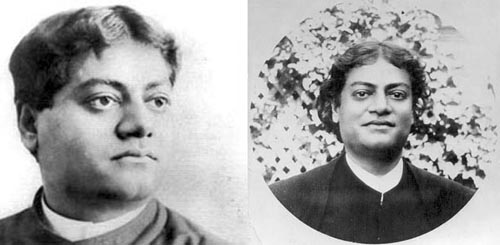
Bisvanath Dutta was a successful lawyer with a lucrative practice at Calcutta High Court. Dutta family also had inherited wealth from at least previous two generations. Bisvanath's grandfather Rammohan Dutta had worked as a managing clerk and business partner to an English lawyer. His father, Durgaprasad, was a brilliant lawyer. Thus there were at least three generations of lawyer Duttas. Yet, all the wealth in the family was not a substitute for intelligence in the family and every Dutta was an overachiever.
Bisvanath's father Durgaprasad had renounced all worldly pleasures and possessions and had suddenly disappeared from family life, leaving his wife and son to tend for themselves. His abandoned wife, a beautiful lady, Shyamasundari by name, now dedicated herself in the upbringing and education of her son Bisvanath. In this endeavor she succeeded as a single mother to her great credit. Bisvanath had become a successful lawyer in the family tradition. Durgaprasad was seen only once after his abandonment of his family, while the family had gone to Varanasi for pilgrimage. No one knows what happened to him after that. The bright lawyer with great potential, whom his father Rammohan Dutta had held in high esteem, had simply disappeared from the world, never to be heard of again.
When Narendranath was growing up, the house beamed with intellectual acumen. Discussions and discourses of all types ' history, philosophy, and religion were frequently held in the house with gatherings of scholars and educated elites of the time in Calcutta. Young Narendranath was encouraged to participate in the family discussions. Bisvanath was proficient in many languages including English, Persian, Arabic and Sanskrit apart from many other Indian languages.
Bisavanath also had another trait he had inherited from his elders. He was overly generous. His altruism had bordered on absurdity. He gave away his wealth indiscriminately. Even when he knew that the recipient was going to squander the money on libations, he still gave it. He felt sorry for the poor souls, saying, 'Let him forget his struggles in a state of drunkenness for a few hours!' Hangers-on and drunkards were even allowed to live at his home taking advantage of the generous rich lawyer. After becoming a sannyasin and came to be called Swami Vivekananda, Narendranath would always say, 'I owe my intellect and compassion to my father.'
Narendranath and father Bisvanath had a very close relationship. He instilled in his son the importance of hard work, independent thinking and kindness to other human beings. He advised his son to read extensively including the Bible and Diwan-i-Hafiz. The son took his father's advice seriously. (In fact, when he later assumed the role of sannyasin and wandered around India, his only two possessions - apart from his change of ochre robes, a water jug and a coarse blanket - were two books, one was the Bhagavad-Gita and the other was The Imitation of Christ). By the time he was twenty years of age, he had an extensive list of books he had read. Narendranath's mother, Bhubaneswari Devi, an extraordinary woman, taught him love, caring and devotion to God. In her household she was a regal queen but at the same time humble and caring. Swami Vivekananda recognized this and always said, 'The love which my mother gave to me, has made me what I am, and I owe a debt to her that I can never repay.'
During his early years Narendranath had an inquisitive mind. He never took an answer for granted but always questioned the validity and looked for solid proof. He was always intrigued by the caste system and different religions. In his father's reception area there were different hookahs set up for people of different religions and castes. Narendranath tried each of the hookahs when no one was watching and declared, 'There is no difference between these hookahs!' His avid rejection of caste later in his life had an early lesson.
All of his intellect was not inherited but a curious mind had formed its own opinions. He also had the gift of a photographic memory and grasped what was in front of him very quickly. He was a prodigy who had read extensively at a very young age. He also learnt music, both instrumental and vocal and had a melodious voice. (He would be one of the lead singers at Brahmo Samaj). In 1879 he entered Presidency College in Calcutta for one year and then joined Scottish Church College, also in Calcutta, where he took philosophy classes. Here he was exposed to western philosophy, logic and European history.
Tragedy Strikes at Home
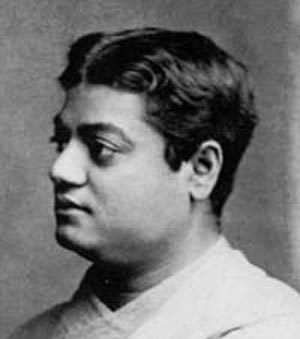
A calamity of great proportion struck Narendranath's family unexpectedly in 1884. His father, Bisvanath suddenly passed away leaving the young widow and her children vulnerable. It was also discovered that Bisvanath had given away most of his wealth to the poor and the needy, leaving the family in a precarious financial position. An aunt of Narendranath staked a claim to the family home and went to court. The bills started mounting and Narendranath was finding it difficult to find suitable employment.
This was a vulnerable period in Narendranath's life. He started doubting the existence of a merciful God. His mind started drifting to atheistic aptitudes. He could not even stand listening to devotional songs any more. He also kept his family troubles private. His pride prevented him from looking for help from others so that his young sisters and brothers could be tended to properly. There was an anonymous donor who was the only one he would accept assistance from. In his later years he always recounted this and thanked the donor for his help. He never forgot the help he and the family received from this kind individual.
Narendra already had different ideas about his life's purpose by this time. He was drifting towards the path his grandfather had taken and the idea of renouncement fascinated him. His mother was not happy with his decision as he was the oldest son and the only potential bread winner for the family now. She wanted him to follow in the foot steps of his father and become a lawyer. After finishing his college, Naren joined law school but his destiny inevitably beckoned him in another direction; to a place called Dakshineshwar, four miles north of Calcutta, where resided a simple uneducated mystic called Sri Ramakrishna.
His father's death could not have occurred at a worse time in his life. He was already conflicted as to what path he ought to follow in his life. He had many unanswered questions that no one could answer to his satisfaction. Now as the oldest son he felt responsible for protecting his family and felt responsible for his younger siblings and his widowed mother. But spiritually he was being pulled in the opposite direction. This indecision between two polar opposite life style would haunt him for the rest of his life, though he found a middle path wherein he deduced that total renouncement was not necessary if one has to follow in the path of a sannyasin. It is not a sin to enjoy life's innocent pleasures (like eating ice cream once in a while), even though one has decided in the path of renouncement as a means to attain salvation.
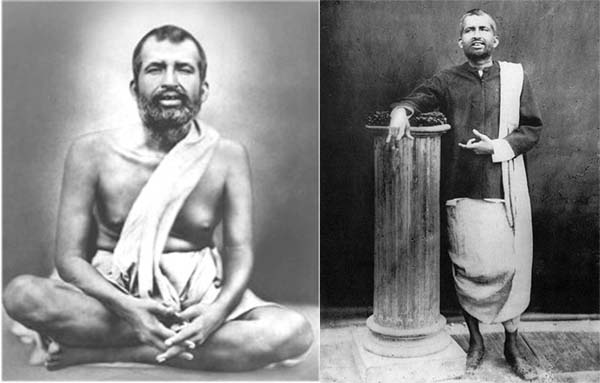
The hardship Narendranath faced also might have prepared him for his later renouncement and adopting a life of sannyasin. This destitution also led him to closer bondage with his mentor Sri Ramakrishna Paramahamsa of Dakshineshwar, a mystic saint. One day, during a lecture on literature by English Professor William Hastie (of what is now called Scottish Church College), poet William Wordsworth's poem 'The Excursion' was being discussed. The professor was saying that the state of mind the poet experiences during his writing of masterpieces can be achieved in real life with utmost inner purity. He had some experiences with the sage Sri Ramakrishna and he suggested that Narendra should meet him to settle his agitated mind.
Narendranath was an active participant in Brahmo Samaj which had split into two factions, one the theistic faction headed by Keshab Chandra Sen and the other more leaning towards social reforms led by Shivnath Sastri. Though he liked the social reform agenda of the latter he could not entirely disagree with Keshab Chandra Sen's embrace of eclectic spirituality. Sastri's group had denounced the idea of image worship, renunciation and the life of a sannyasin. Narendranath was attracted to the idea of renunciation as a path to spiritual emancipation, like his grandfather.
Curiosity and a yearning for God brought him face to face with Sri Ramakrishna. He had posed the question, 'Have you seen God?' to many a learned gurus including Devendranath Tagore of Brahmo Samaj. He had never received a satisfactory answer. Eventually, he began to expect the answer to the question to be always evasive and vague. He always knew what the answer would be and this deeply disappointed him.
Then in November of 1881 (three years before his father's death), Narendranath was invited to sing in a gathering, which the saint was to attend. The great Master took an immediate liking to the young man with the melodious voice. Narendranath's affinity to the master was more gradual, with periods of indecisions and self doubts. His first impression about the Master was not flattering at all. Rather he thought the saint was insane. But he still was drawn towards Dakshineshwar and visited often. Gradually Sri Ramakrishna won over Narendranath's heart. His bondage with the saint grew stronger especially after his father's death in 1884.
But the tumult that Narendranath felt and his doubts drew him closer to Sri Ramakrishna, who immediately reciprocated and made Naren his principal disciple. For the next five years he frequented Dakshineshwar and in the process neglected even to appear for his final examination in law. This happened especially when the saint was ill with throat cancer before his death on August 16, 1886. (During his last year of life, Sri Ramakrishna had moved to a garden house in Cossipore for medical treatment).
Spiritual Education
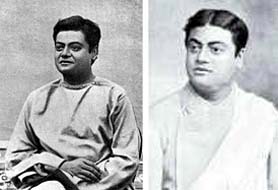
Sri Ramakrishna carefully guided Narendranath through his spiritual journey. Most of the time he knew what was in his young disciple’s mind before he even asked the question. His question about the existence of God was answered by the Master to Narendranath’s satisfaction. He also showed him the path to mystical experience and ecstasy and Samadhi.
The Master also reinforced the feelings Narendranath had towards humanity at large. Helping and serving other human beings, who were God’s children was of utmost importance. Dakshineshwar was not an ordinary place where devotees came to listen to the great Master talk. Instead it was a place where men of great intellect gathered (along with poets and scholars, both sober and alcoholics but honest and truthful), to have open discussions with Sri. Ramakrishna. He charmed them all with his wit and sense of humor.
God consciousness does not exclude fun and laughter. Renunciation does not mean one is not allowed to enjoy an ice cream once in a way. The great Master also taught tolerance towards other religions. If there are faults in other religions that we may see, it is not our business. God can correct the faults in those religions as well as faults in our own religion. This attitude of the Master had attracted poor and earnest people from all religions – Hindu, Muslim, Christian and Sikh – to come to Dakshineshwar and seek his guidance.
Narendranath was guided by Sri Ramakrishna to experience the bliss that he longed for, where everything appeared to be permeated by God and the vast conscientiousness lost all forms of distinction. Narendranath, however, maintained an independent streak and did not agree that bhakti (devotion) was all that was needed to attain a state of bliss. He often characterized bhakti as sentimental nonsense and considered it a mask for weakness of character in a person. Sri Ramakrishna always thought Narendranath was the best agent to spread the word and make his teachings more available to the general public. A complete immersion of self into the state of vast conscientiousness and total renouncement would be counterproductive in the scheme of things. Narendranath instead kept in touch with the physical world and felt the suffering of the world and dedicated his life to alleviating that suffering as far as he could.
For medical treatment Sri Ramakrishna had been moved to Shyampukur and then to Cossipore garden-house. He was advised by his physician to refrain from speaking lest he tire his voice. But Sri Ramakrishna continued to conduct his discussions with his disciples and followers at Cossipore. Narendranath was spending an inordinate amount of time in Cossipore, looking after the welfare of his Master, much to the consternation of his family. His mother visited the Master and pleaded him to send Narendra home which the sage readily agreed to do. But Narendra had deeply committed his future to the guidance shown by his Master.
Continued
Page 1 | 2 | 3 | 4
22-Feb-2009
More by : Dr. Neria H. Hebbar

|
i am proud to be an Indian.And swamiji is my hero |

|
A wonderful assessment of a wonderful man. |